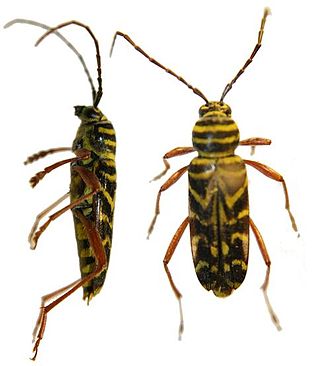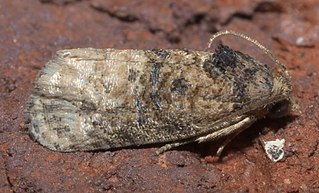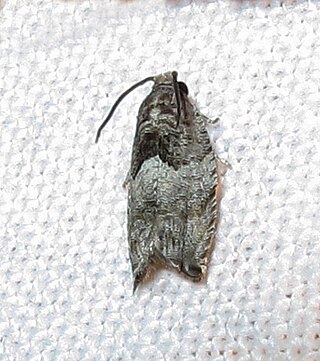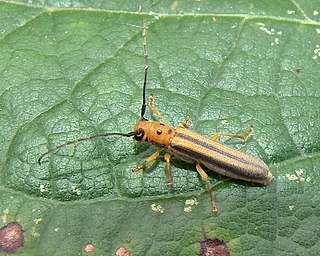
The Tortricidae are a family of moths, commonly known as tortrix moths or leafroller moths, in the order Lepidoptera. This large family has over 11,000 species described, and is the sole member of the superfamily Tortricoidea, although the genus Heliocosma is sometimes placed within this superfamily. Many of these are economically important pests. Olethreutidae is a junior synonym. The typical resting posture is with the wings folded back, producing a rather rounded profile.

Megacyllene robiniae, commonly known as the locust borer, is a species of longhorn beetle endemic to eastern North America. It is a serious pest of Robinia pseudoacacia, the black locust tree, with which it is sympatric.

Acleris semipurpurana is a species in the moth family Tortricidae, and one of several species of moth commonly known as oak leaftier or oak leaf tier. The larvae feed on the leaves of oak trees in the Eastern United States and southeastern Canada which can be a major cause of defoliation. The loss of leaves can kill or damage the affected trees, which are chiefly in the Lobatae or red oak section of Quercus, or oaks.

Ecdytolopha is a genus of moths belonging to the subfamily Olethreutinae of the family Tortricidae.

Ochetarcha is a genus of moths belonging to the subfamily Tortricinae of the family Tortricidae. It contains only one described species, Ochetarcha miraculosa, also known as the ponga stem borer, which is found in New Zealand.

Epiblema strenuana, the stem-galling moth or ragweed borer, is a moth of the family Tortricidae. It is endemic to North America, but was introduced to Australia from Mexico to control the weeds of the family Asteraceae in 1982. It is occasionally misspelled as Epiblema strenuanum.
Tetramoera schistaceana, the grey borer of sugar cane, is a moth of the family Tortricidae. It is found in Indonesia (Java), China (Guangdong), Taiwan, Malaysia, the Philippines, Mauritius, Hawaii, Madagascar and Réunion.

Proteoteras aesculana, the maple twig borer, early proteoteras or maple tip moth, is a moth of the family Tortricidae. It is found from coast to coast in the northern United States, south to Mississippi in the east and to California in the west. It has a scattered distribution in Canada, from Nova Scotia to southern Alberta.

Chilo suppressalis, the Asiatic rice borer or striped rice stemborer, is a moth of the family Crambidae. It is a widespread species, known from Iran, India, Sri Lanka, China, eastern Asia, Japan, Taiwan, Malaysia to the Pacific.

Bactra venosana, the nutgrass borer or nutsedge borer, is a moth of the family Tortricidae. It was first described by Philipp Christoph Zeller in 1847. Julius von Kennel provides a full description. It has a wide distribution, from southern Europe, North Africa and Asia Minor to India, Sri Lanka, southern China, Malaya, Australia and into the Pacific where it is found on Java, Borneo, the Philippines, Taiwan, Timor, the Solomons, the Carolines and Fiji. It was introduced to Hawaii in 1925 to control nutsedge. It is now found on Kauai, Oahu, Molokai, Maui, Lanai and Hawaii.

Crocidosema lantana, the lantana flower-cluster moth or lantana tortricid moth, is a moth of the family Tortricidae. It was first described by August Busck in 1910. It is native to Mexico and the southern United States, but was introduced to Hawaii in 1902, Australia in 1914 and the Caroline Islands in 1948 and 1949 to aid in the control of Lantana weeds. It has also been recorded from Yunnan, China and in Sri Lanka.

Grapholita molesta, the oriental fruit moth or peach moth, is a moth of the family Tortricidae. It is native to China, but was introduced to Japan and North America and is now also found throughout of Europe, Asia and South America and in Hawaii, Morocco, Mauritius, South Africa, Australia and New Zealand

Proteoteras willingana, the eastern boxelder twig borer moth, is a moth of the family Tortricidae. It is found in southern Canada and the eastern United States, west through the Great Plains.

Gypsonoma haimbachiana, the cottonwood twig borer, is a moth of the family Tortricidae. It is found in eastern North America, from Canada to the Gulf Coast of the United States and west to Missouri.

Hystrichophora taleana, the indigobush twig borer, is a moth of the family Tortricidae. It is known from the United States, where it was found in Washington and Sharkey counties in Mississippi and Chico County in southeastern Arkansas.

Polyphagozerra coffeae, the red coffee borer or coffee carpenter, is a moth of the family Cossidae. It was described by John Nietner in 1861 and is found in Asia. Records from the Moluccas and New Guinea refer to Polyphagozerra reticulata, which was previously considered to be a synonym of P. coffeae. It is a widespread pest that attacks many plants.

Gymnandrosoma punctidiscanum, the dotted ecdytolopha moth, is a moth of the family Tortricidae. It is found in North America, where it has been recorded from Alabama, Arkansas, Florida, Georgia, Illinois, Indiana, Kentucky, Maine, Maryland, Massachusetts, Michigan, Minnesota, Missouri, New Jersey, New York, North Carolina, Ohio, Oklahoma, Ontario, Pennsylvania, Quebec, South Carolina, Tennessee, Virginia, and West Virginia.

Oberea tripunctata, the dogwood twig borer, is a species of longhorn beetle that is a widespread pest that attacks dogwood trees.

Xylosandrus compactus is a species of ambrosia beetle. Common names for this beetle include black twig borer, black coffee borer, black coffee twig borer and tea stem borer. The adult beetle is dark brown or black and inconspicuous; it bores into a twig of a host plant and lays its eggs, and the larvae create further tunnels through the plant tissues. These beetles are agricultural pests that damage the shoots of such crops as coffee, tea, cocoa and avocado.
Lusterala is a monotypic, neotropical genus of tortix moths provisionally assigned to tribe Grapholitini of subfamily Olethreutinae, with Lusterala phaseolana as sole species.





















